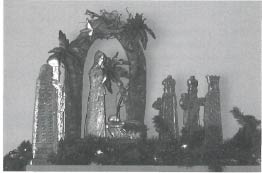I admit it. I’m a self-professed worship nerd. I’ve been known to match the color of the runner on my office table to the current season of the church year. In fact, just about all the décor in my office and home is liturgical in nature. I like to surround myself with reminders of who I am in the much larger scheme of God’s plan of redemption. At Christmas, of course, the décor includes a nativity set.
Each year at Christmastime I carefully unwrap each figure: the child in the manger, Mary, and five male figures: three wise men bearing gifts and either two shepherds or a shepherd and Joseph.
But here’s my dilemma: the picture these figures create on my mantel each year is all wrong! Some might even call it sentimental Western drivel.
The real scene of Christ’s birth would more closely resemble a back alley scene on a 20/20 news special then the gilded pomp and soft back-lighting suggested by my nativity set and portrayed on many Christmas cards.
The shepherds who appeared that night were poor, overlooked members of society. They had no legal rights. Yet these shepherds—the forgotten, the abused, the hardworking but underpaid, the uneducated—were the first to whom the miracle of the incarnation was announced. They believed, and they worshiped the Christ-child.
The wise men also really have no place in the nativity scene. They didn’t arrive in Bethlehem until Mary and Joseph had settled into a home of their own and the baby Jesus had become a busy toddler. Despite the fact that we often refer to them as “three wise men” or “three kings,” nothing in Scripture indicates that there were three of them, or that their names were Gaspar, Melchior, and Balthazar, or even that they were all men. (In 2004 the Church of England chose to refer to them simply as “magi” in order to leave room for the possibility that there may have been one or more women in their group.)
What we do know is that these magi saw an unusual light in the sky. Whether it was a new star, a comet, or a planetary conjunction is not clear. The point of Matthew’s gospel is that God was behind the sign in the sky. These magi, who lived somewhere to the east of Israel (probably in what is now Iraq or Iran) knew enough about Jewish prophecy to be compelled to journey west to find this newborn king.
The journey would have taken several months, and the terrain was desolate. The forces of nature were against them, and they had to guard against robbers who were eager to finish them off if the elements didn’t. They probably took along an entourage of servants and armed guards to protect the precious gifts they carried. Chances are that they arrived in Bethlehem with wind-burned skin, clothes whose original color was hard to ascertain, and calloused feet encased in worn sandals. Nothing like the royal trio depicted in my nativity scene.
But here’s the point: in the midst of the earthy, sweaty reality of Christ’s birth, the star shines. And that birth ushers in a new reality. From the genealogy of Christ at the beginning of Matthew to the story of the shepherds and magi and the miracle of God made flesh in Christ, the whole gospel narrative points to this new reality. In this new order, it is not the Herods of the world who are deemed important, but the poor. It is not the “in crowd” who see the light, but the foreigners. And that light shines most brightly in the darker places of life.

Am I guilty of walking past the dark alley where the unwed teen gave birth to her son and looking the other way because I don’t want to get involved? Do I see the foreigner and worry about my safety rather than stopping to offer a hand of hospitality? Am I too busy to pay attention to the many ways that God is calling me to himself?
The gospel message is not easy. It is not clean or comfortable. But it is filled with hope. God loved us enough to send his Son to live among us, to feel, to laugh and cry, to mourn, to hunger, to die. Christ loved us enough to subject himself to all forms of degradation so that we might rise to newness of life. By joining with Christ in his suffering for this world we will also join him in the establishment of a new kingdom.
Meanwhile, I’m left with the dilemma of what to do about my nativity set. Or am I just being too much of a worship nerd?

